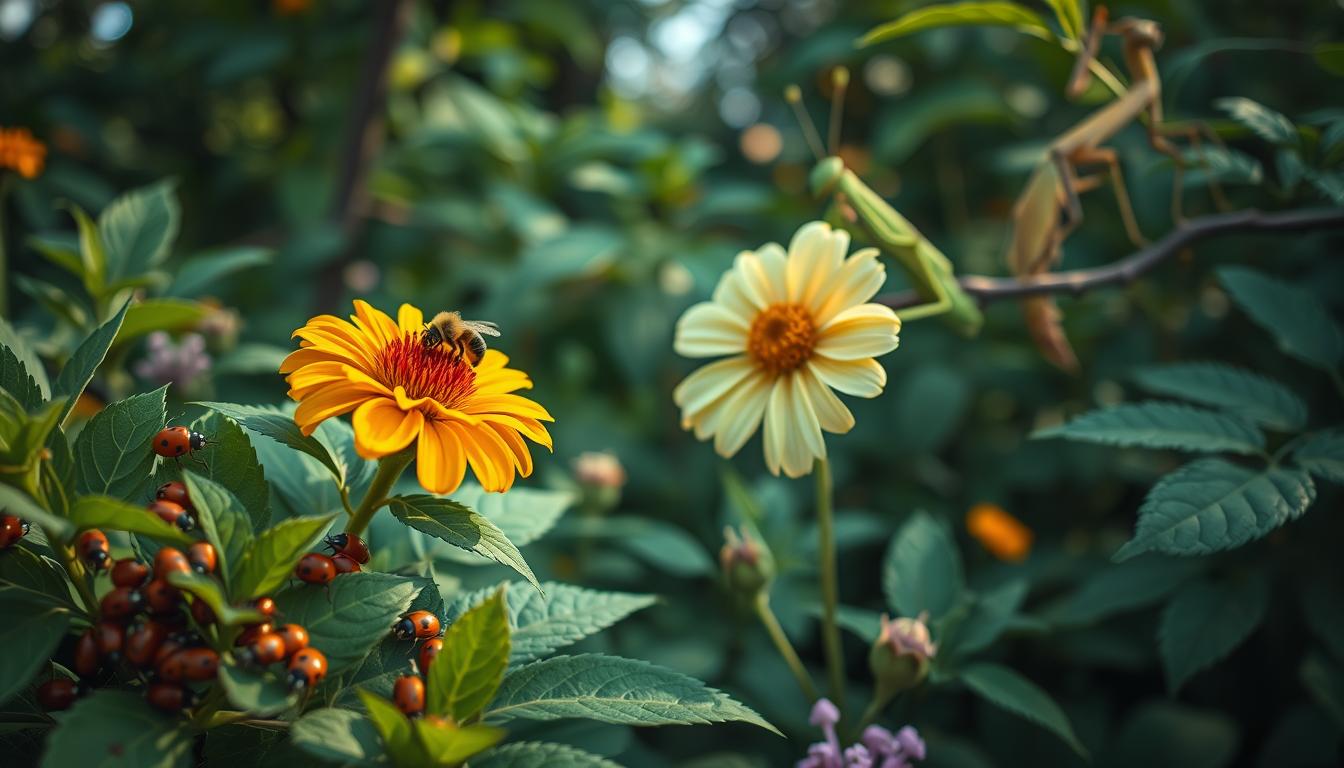Imagine your garden as a tiny ecosystem where nature’s own workforce helps keep problems in check. The secret allies in this system are the helpful critters that naturally control pests without chemicals or sprays. These garden partners work around the clock, munching on troublemakers that damage your precious plants.
When you welcome these natural helpers into your outdoor space, you’re creating a balanced environment that largely manages itself. Ladybugs feast on aphids, while ground beetles hunt slugs and snails that would destroy your vegetables.
The beauty of natural pest control lies in its simplicity. By understanding which creatures benefit your garden, you can create habitats that attract and keep them around. This approach leads to healthier plants, reduced chemical use, and a more sustainable gardening practice.
Your backyard can transform from a constant battleground against unwanted visitors into a thriving community where nature’s checks and balances do most of the work. Let’s explore the fascinating world of these garden allies that might already be hiding among your flowers and vegetables.
The Hidden Heroes of Your Garden Ecosystem
Your garden has a secret team of beneficial insects. They keep the ecosystem balanced without being noticed. These tiny workers do important jobs like pollination and pest control. It’s hard and expensive for humans to do these tasks.
Walking into your garden, you enter a world of complex interactions. Predators, prey, decomposers, and pollinators all play key roles. These relationships have evolved over millions of years, keeping your garden healthy.
Understanding the Balance of Nature
In a healthy garden, beneficial insects act as natural biological control. For every pest, there’s a predator insect to keep it in check. This balance means fewer pests and healthier plants, without the need for chemicals.
Even a small backyard garden is a mini-ecosystem with complex food webs. Ladybugs eating aphids and ground beetles hunting slugs are part of these ancient relationships. These interactions keep the ecosystem balanced.
Diversity is key to a thriving garden. Gardens with many plants and insects are more resilient. Supporting beneficial insects strengthens this resilience and reduces the need for artificial pest control.
The Economic Value of Insect Services
Beneficial insects do more than just fascinate us—they have great economic value. Insect pollination is worth $235-577 billion a year, according to Nature. This shows how vital these tiny creatures are to our food systems.
In home gardens, beneficial insects offer free pest control, saving hundreds of dollars. A single ladybug can eat up to 5,000 aphids, while ground beetles can cut slug damage by 70%.
Decomposer insects like beetles and flies improve soil by breaking down organic matter. This natural soil improvement would cost a lot in commercial fertilizers. With pollination and pest control, the total value of insects in a garden can be hundreds of dollars a year.
By supporting these hidden heroes, you’re not just making your garden prettier. You’re also making a smart choice that saves money and benefits your plants.
Beneficial Insects for Gardens: A Complete Overview
Knowing which insects help your garden means looking beyond their looks. Many insects are actually good for your garden, not pests. These beneficial insects help your garden grow without needing chemicals.
Defining What Makes an Insect “Beneficial”
An insect is called “beneficial” based on its role in the garden, not its looks. Many think all insects harm plants or spread disease. But, less than 1% of insects are harmful to gardens or humans.
Some beneficial insects might look scary. For example, the praying mantis eats pests. The wheel bug eats harmful caterpillars and beetles with its long beak.
What makes an insect beneficial is its role in the garden. They pollinate, control pests, recycle nutrients, or improve soil. Many insects do more than one job, helping the garden thrive.
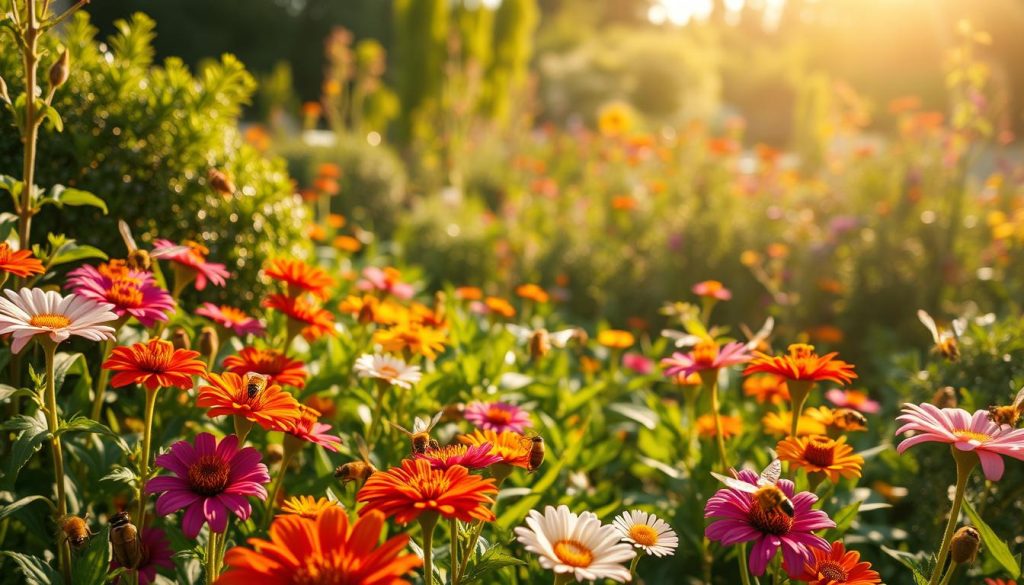
The Three Main Categories: Pollinators, Predators, and Decomposers
Beneficial insects fall into three main groups. Each group plays a key role in garden health. Knowing these groups helps gardeners support the right insects.
Pollinators, like bees and butterflies, are very visible. They move pollen between flowers, helping plants reproduce. Without them, many plants wouldn’t produce fruits or seeds.
Predatory insects control pests. Ladybugs and lacewings eat aphids and other pests. A single ladybug can eat up to 5,000 aphids, showing their power.
Decomposers break down dead plants and animals. Beetles and flies turn this into nutrients for the soil. They help plants grow by making soil rich in nutrients.
Pollinators: The Garden’s Most Valuable Visitors
Flowers and pollinators have a special bond in your garden. Without these hard workers, many plants wouldn’t grow seeds, fruits, or veggies. In fact, pollinators help us eat one out of every three bites of food. They also help keep biodiversity and support wildlife that eats fruits and seeds.
Pollinator insects move pollen between flowers, helping them make seeds and fruits. Gardens with many pollinators often have bigger, more fruitful harvests.
Native Bees vs. Honey Bees
Honey bees get a lot of attention, but North America has over 4,000 native bee species. Mason bees, for example, pollinate up to 100 times more than honey bees in fruit orchards. These bees don’t make honey but focus on pollination.
Native bees have special relationships with local plants. Bumblebees, for instance, use special buzzing to pollinate plants like tomatoes and blueberries. Unlike honey bees, most native bees live alone in soil, wood, or stems.
Honey bees are great for big farms, but they face challenges like colony collapse. Native bees need more help because they face different problems. Both types are important, but native bees need special care.
Butterflies and Moths: Beautiful and Beneficial
Butterflies add beauty and help pollinate gardens as they visit flowers. Their long proboscis lets them reach nectar in deep flowers. While not as good at pollen transfer as bees, they visit more flowers.
Moths pollinate plants that bloom at night, like jasmine and moonflower. Some plants have evolved to attract moths with strong scents and pale colors at night.
To help butterflies and moths, we need to think about their host plants. For example, milkweed for monarchs and dill for swallowtails are essential. This creates a complete home for these beneficial insects.
Overlooked Pollinators: Flies, Beetles, and Wasps
Many insects help pollinate gardens, not just bees and butterflies. Hover flies, with their bee-like look, pollinate many flowers and eat aphids. They are very useful in gardens.
Beetles have been pollinating for millions of years, even before bees. They pollinate plants like magnolias and wildflowers. Solitary wasps also pollinate while hunting pests that harm plants.
| Pollinator Type | Pollination Efficiency | Preferred Flowers | Additional Benefits |
|---|---|---|---|
| Native Bees | Very High | Varies by species; many native wildflowers | Require no management; active in cool/wet conditions |
| Honey Bees | High | Diverse; prefer mass-flowering plants | Produce honey; can be managed in hives |
| Butterflies | Moderate | Flat-topped flowers with landing platforms | Aesthetic value; indicator of ecosystem health |
| Hover Flies | Moderate | Small, open flowers with accessible nectar | Larvae consume aphids and other pests |
| Beetles | Low to Moderate | Bowl-shaped flowers with exposed pollen | Many species also control soil pests |
Ladybugs: The Gardener’s Spotted Allies
Ladybugs are more than cute; they are fierce fighters against garden pests. These tiny insects can eat up to 5,000 aphids in their lifetime. They are a sign of a healthy garden where nature’s balance is maintained.
There are over 5,000 ladybug species worldwide, with about 500 in North America. Their spots and bright colors warn predators they taste bad. This is a clever defense mechanism in nature.
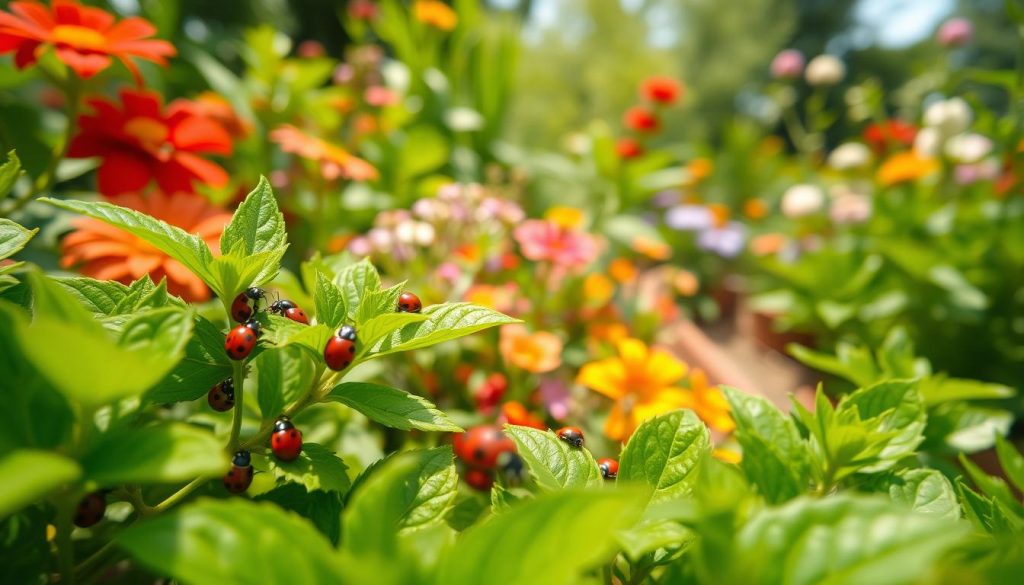
Identifying Native vs. Invasive Ladybug Species
Not all ladybugs are good for your garden. Native species like the Nine-spotted Ladybug and the Convergent Lady Beetle are great for pest control. They don’t cause problems.
The Asian Lady Beetle, though, is a different story. It’s an invasive species that can bite and smell bad. It’s known for its M-shaped mark and aggressive behavior.
Native ladybugs are rounder and brighter, while Asian ones are oval and range from yellow to red. Knowing the difference helps you spot the beneficial ones in your garden.
Ladybug Life Cycle and Feeding Habits
Ladybugs go through four stages: egg, larva, pupa, and adult. Female ladybugs lay eggs near aphids, giving their young a quick food source.
The larvae look like “alligators” and eat 20-50 aphids a day. They are the most active stage in eating pests.
After 2-3 weeks, they become pupae and transform into adults. Adults hunt pests but also eat pollen and nectar when aphids are scarce.
How to Attract and Keep Ladybugs in Your Garden
To attract ladybugs, avoid broad-spectrum pesticides. Instead, create a habitat that meets their needs at every stage of their life.
Plant a variety of flowers that offer pollen and nectar. Leave some aphids for food. Without prey, ladybugs will leave your garden.
Provide shallow water and shelter with rocks, logs, or insect hotels. For winter, leave leaf litter for hibernation.
| Characteristic | Native Ladybugs | Asian Lady Beetles (Invasive) | Garden Impact |
|---|---|---|---|
| Appearance | Rounded shape, bright red | More oval, orange to red, M-shaped mark behind head | Both effective for pest control |
| Behavior | Gentle, rarely bite | More aggressive, may bite | Native species cause fewer problems |
| Winter habits | Hibernate outdoors | Often invade homes | Invasive species can become household pests |
| Pest control ability | Excellent – focuses on garden pests | Very good but less specialized | Both consume significant numbers of aphids |
| Conservation status | Many species declining | Expanding range | Supporting natives helps biodiversity |
Predatory Insects That Hunt Garden Pests
Many insects in your garden are not pests but predators. They hunt down pests with great skill. These insects are key to a healthy garden, working quietly to keep pests in check.
Their work helps reduce the need for harmful chemicals. This supports the overall health of your garden.
Lacewings: The Aphid Lions
Lacewings have beautiful, transparent wings and bright colors. But their larvae are fierce eaters. They can eat up to 200 aphids a week, helping control pests.
Lacewings lay their eggs on plant leaves, safe from ants and other threats. Look for lacewings by their net-like wings, eggs on stalks, and alligator-like larvae.
Praying Mantis: Fascinating Hunters
Praying mantises are well-known for their hunting skills. They hold their front legs like they’re praying, waiting to strike. Don’t be fooled by their calm look—they are quick and deadly.
These insects can grow up to 4-5 inches long. They eat big pests like caterpillars and even small frogs. Their heads can turn 180 degrees, helping them see all around.
But mantises eat all insects, including bees and butterflies. This makes them less specific in controlling pests.
Assassin Bugs and Ambush Predators
True assassin bugs, ambush bugs, and damsel bugs are also great hunters. They use different ways to catch and eat their prey. Assassin bugs grab insects with their legs and then pierce them.
Ambush bugs hide in flowers, surprising insects. Damsel bugs are slender and agile, searching for aphids and caterpillars.
These predators work together to protect your garden. They often stop pest problems before you even notice.
Ground Beetles and Other Soil Dwellers
Ground beetles are the unsung heroes of natural pest control. They work hard beneath mulch, stones, and leaves to keep your garden healthy. These ground-dwelling allies are often overlooked because they’re rarely seen in daylight.
The Nighttime Patrol of Ground Beetles
Ground beetles belong to the Carabidae family, with over 2,500 species in North America. They are mostly active at night, hunting slugs, snails, cutworms, and root maggots.
You can spot them by their shiny, black or metallic bodies. They have ridged wing covers and long legs for speed. Unlike flying insects, they scurry across the soil when disturbed.
Ground beetles are great for natural pest control because they eat a lot. One beetle can eat its weight in prey every day. They use their strong mandibles to crush soft-bodied pests like slug eggs and small caterpillars.
Soil Health Improvers: Centipedes and Millipedes
While ground beetles hunt, centipedes and millipedes improve soil health in different ways. Centipedes and millipedes have different roles in your garden ecosystem.
Centipedes are fast predators with one pair of legs per segment. They have venomous front legs to catch and immobilize prey. They move quickly across the soil surface.
Millipedes are slow-moving decomposers with two pairs of legs per segment. They feed on decaying plant matter, breaking it down into nutrients for plants. When threatened, they curl into a tight spiral.
| Soil Dweller | Primary Role | Diet | Identification Tips | How to Attract |
|---|---|---|---|---|
| Ground Beetles | Predator | Slugs, snails, cutworms, root maggots | Shiny black/metallic, ridged wing covers | Mulch, leaf litter, minimal soil disturbance |
| Centipedes | Predator | Small insects, worms, arthropods | Flattened body, one pair of legs per segment | Moist soil, rocks, logs, leaf piles |
| Millipedes | Decomposer | Dead plant material, fungi | Cylindrical body, two pairs of legs per segment | Organic matter, compost, wood chips |
| Rove Beetles | Predator | Soil pests, fly eggs, small larvae | Short wing covers, raises abdomen when threatened | Organic mulch, minimal pesticide use |
To support these valuable soil dwellers, keep some areas of your garden undisturbed. Add leaf mulch and avoid chemical pesticides. A 2-3 inch layer of organic mulch is perfect for them.
A healthy population of ground beetles and other soil dwellers means a balanced garden ecosystem. Though they may not be as colorful as butterflies or as cute as ladybugs, they are crucial for keeping your garden pest-free.
Parasitic Wasps: Microscopic Garden Defenders
Parasitic wasps in your garden might be your best allies. They are tiny, unlike their larger relatives. These wasps are experts at controlling pests without harming plants or pets.
Most gardeners don’t see these tiny heroes at work. Yet, they play a huge role in keeping pests away. A healthy garden can have dozens of wasp species, each targeting specific pests.
How Parasitic Wasps Control Caterpillars and Aphids
Parasitic wasps have a clever way to control pests. Female wasps lay eggs inside or on pests. The larvae then feed on the host, killing it.
Braconid wasps are a common sight in gardens. They leave white cocoons on tomato hornworms. This shows the caterpillar has been controlled. One female braconid can kill dozens of caterpillars.
Trichogramma wasps target pest eggs before they hatch. These tiny insects inject their eggs into moth and butterfly eggs. Aphid parasites turn aphids into golden “mummies” on plants.
Attracting These Tiny But Powerful Allies
To attract parasitic wasps, you need to understand their adult needs. They feed on nectar and pollen from flowers. Small, shallow blooms are perfect for them.
Plants like sweet alyssum and dill are great for parasitic wasps. Letting herbs like cilantro and parsley flower helps too. Bare soil areas also attract ground-dwelling wasps.
Avoiding broad-spectrum insecticides is key. These chemicals harm beneficial insects too. Even organic pesticides can be dangerous if used without care.
These wasps are harmless to humans. They’re too small to sting and focus on finding their hosts. By welcoming them, you get a dedicated team protecting your garden.
Creating a Haven for Beneficial Insects
Creating a space where beneficial insects thrive is both an art and a science. It rewards gardeners with natural pest control. By designing your outdoor space with these creatures in mind, you’re not just growing plants. You’re creating a living ecosystem that works with nature.
The right plants, water sources, and shelter can turn a small garden into a biological pest management powerhouse. This transformation is key to a healthy garden.
Native Plant Selection for Maximum Attraction
Native plants are the heart of any garden that supports beneficial insects. They have evolved with local insects for thousands of years. This makes them more attractive and nutritious than many exotic plants.
Research shows native plants support up to 4 times more beneficial insect species than non-natives. This is crucial for a balanced garden ecosystem.
When picking plants, choose a variety of shapes, sizes, and colors. Different beneficial insects have different needs. A diverse plant palette ensures you’re helping the widest range of beneficial insects.
Early Season Bloomers
Spring-flowering plants are essential when beneficial insects first emerge from winter. Include natives like wild columbine, spring beauty, and serviceberry in your garden. These plants offer pollen when few other sources exist.
Early bloomers like pussy willow and redbud trees are also valuable. They provide pollen when it’s scarce. This helps establish strong populations of pest controllers before pests become a problem.
Mid and Late Season Support
Summer and fall-blooming plants keep beneficial insect populations strong throughout the growing season. Black-eyed Susans, purple coneflowers, and goldenrod provide nectar as temperatures rise. Late-season bloomers like asters and ironweed help insects build energy reserves before winter.
Plant these in clusters to create “insect filling stations.” This makes them easily spotted from above.
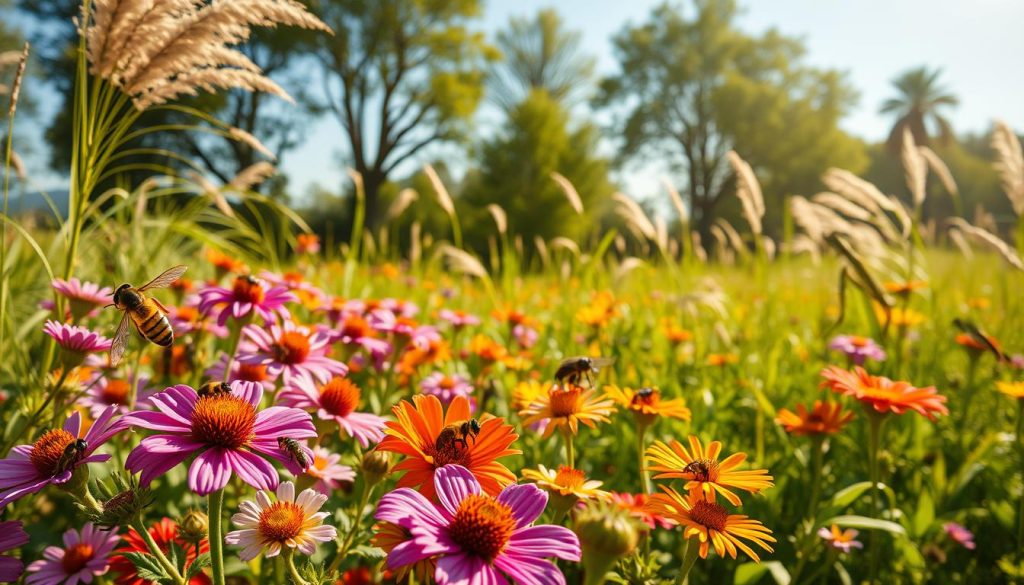
Water Sources, Shelter, and Overwintering Sites
Beneficial insects need more than food—they need water, shelter, and safe places to reproduce and overwinter. Create shallow water sources using bird baths with pebbles or small dishes filled with stones and water. These provide safe drinking spots without drowning risks.
Insect hotels made from bundled hollow stems, drilled wood blocks, and pine cones offer nesting sites for solitary bees and predatory wasps. These structures can be both functional and decorative in your garden design.
Leave some areas of your garden undisturbed through winter. Leaf litter, standing perennial stems, and unmulched soil provide critical overwintering habitat for many beneficial insects. Even a small “wild corner” can serve as a refuge for hibernating ladybugs, ground beetles, and other natural pest controllers.
Avoiding Practices That Harm Beneficial Insects
Even the most insect-friendly garden can become a death trap if certain harmful practices aren’t avoided. Chemical pesticides—even organic ones—rarely discriminate between pests and beneficial insects. Instead, spot-treat problems or use physical barriers like row covers when necessary.
Excessive fall cleanup strips away overwintering habitat. Leave seed heads and stems standing until spring. This protects insects and provides winter interest and food for birds.
Outdoor lighting disrupts nocturnal insect behavior and can create easy targets for predators. Use motion sensors, timers, or yellow “bug lights” to minimize this impact. These simple adjustments make your garden more hospitable to the insects that help keep it healthy and productive.
Integrated Pest Management With Beneficial Insects
Integrated Pest Management (IPM) helps gardeners work with nature, not against it. Instead of using chemicals right away, IPM guides you to make smart choices. It uses beneficial insects to protect your plants and the environment.
The Five Principles of IPM for Home Gardeners
IPM has five key principles for home gardeners. First, prevent pests by gardening wisely. Choose strong plants, space them right, and keep them healthy. This stops problems before they start.
Second, know the difference between pests and helpful insects. Many people harm the good guys by mistake. A magnifying glass and a field guide can help you tell them apart.
Third, check your garden often to catch issues early. Regular checks help you spot problems before they get worse. Look under leaves and check soil and plant health.
Fourth, decide when to act based on the damage. Ask if the damage is just cosmetic or if beneficial insects are handling it. Most gardens can handle some pests without harm.
Lastly, use the least toxic methods first. Start with hand-picking, water sprays, or biological controls like Bt. Only use chemicals if needed.
When to Intervene and When to Let Nature Work
Learning when to act takes time and patience. Look for signs that beneficial insects are fighting pests. Aphid mummies, ladybug eggs, and syrphid flies show your garden is defending itself.
Think about the plant’s age and importance before acting. Young plants and food crops need quick action. But some pests are good for your garden, like aphids for ladybugs.
Watch for changes in pest and beneficial insect numbers. If beneficial insects are growing and pests are stable or falling, nature is working. This balance takes time, even in new gardens.
If pests suddenly increase or beneficial insects are scarce, you might need to act. Even then, choose methods that don’t harm beneficial insects, like insecticidal soaps.
The best gardeners know IPM is about balance. It’s not about getting rid of all pests. It’s about creating a healthy ecosystem where beneficial insects can help control pests.
My Garden Transformation Through Biological Control
My backyard changed from a pest haven to a balanced ecosystem. This taught me more about gardening than books could. Five years ago, I battled aphids, cabbage worms, and spider mites daily. I thought about using chemical sprays but then wondered if I could work with nature instead.
This led me to biological control. It uses beneficial insects to manage pests naturally.
From Pest Problems to Balanced Ecosystem
My garden’s journey started with desperate measures. Aphids covered my roses, tomato hornworms ate my vegetables, and Japanese beetles harmed my fruit trees. I began by planting native flowers like coneflowers, black-eyed Susans, and yarrow to attract beneficial insects.
The transition wasn’t easy. For weeks, pest damage seemed worse. I nearly gave up when my kale was almost gone. But patience was key in biological control.
By midsummer, ladybugs, lacewings, and hover flies appeared in growing numbers.
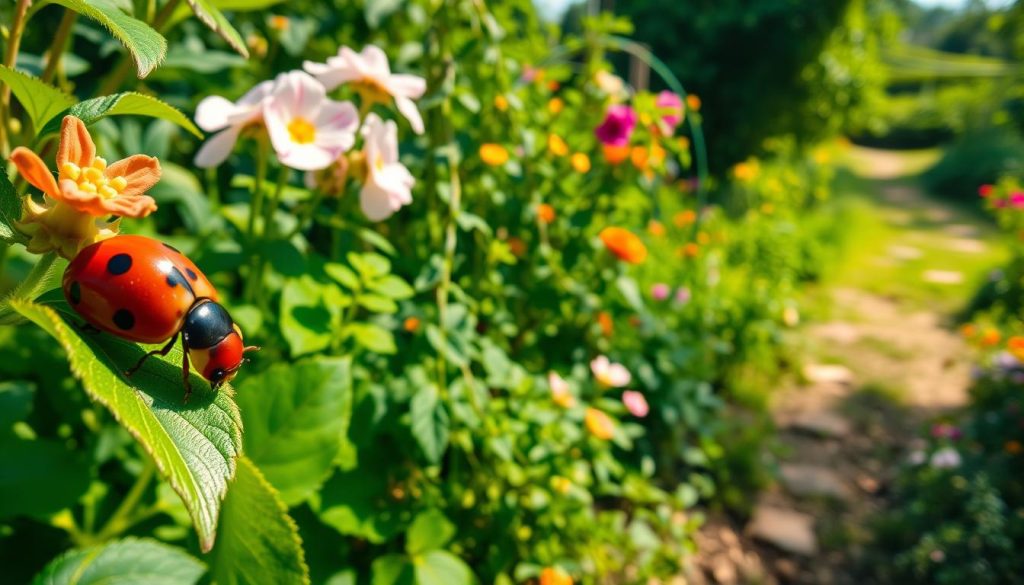
By the second year, the change was clear. Aphid colonies disappeared before causing damage. Parasitic wasps controlled tomato hornworms, leaving white cocoons on their backs. The garden didn’t become pest-free but found balance.
Surprising Observations and Lessons Learned
Beneficial insects appeared quickly after I stopped using broad-spectrum insecticides. Species like tiny parasitic wasps and soldier beetles showed up within weeks.
I learned that some pest presence is necessary. Without aphids, ladybugs wouldn’t stay. This changed my view on garden pests.
Water sources became crucial. Adding a bird bath with stones for insect perches increased pollinator diversity. Predatory insects even used water features to hunt.
| Pest Problem | Traditional Solution | Biological Control Method | Results |
|---|---|---|---|
| Aphid infestation | Insecticidal soap spray | Ladybugs and lacewings | 80% reduction in 3 weeks |
| Cabbage worms | Bt spray applications | Paper wasps and parasitic wasps | Manageable damage, no spraying needed |
| Tomato hornworms | Hand-picking and destroying | Braconid wasps | Natural parasitism controlled population |
| Spider mites | Miticide applications | Predatory mites and moisture management | Occasional outbreaks but quick natural recovery |
The Future of Gardening With Nature’s Helpers
Climate change and habitat loss are big threats to insects worldwide. Our gardens are now key places for them to survive. By welcoming beneficial insects, we help them and our planet.
Research shows plants and insects have a deep connection. Plants call for help when attacked, sending out signals to attract the right insects. This natural defense has been around for millions of years.
Gardeners can now help by tracking and reporting insect sightings. Apps like iNaturalist and Bumble Bee Watch turn these reports into important data. This data helps protect these vital creatures.
Adopting insect-friendly gardening is more than just controlling pests. It’s about working with nature, not against it. By supporting beneficial insects, we become part of a larger movement of gardeners.
Your garden can connect to a network of insect-friendly spaces. Every native plant and habitat feature you add helps. Together, we can rebuild the web of life.
The future of gardening is about partnering with nature’s helpers. By welcoming these tiny allies, we’re not just growing plants. We’re growing hope for a more balanced world.

